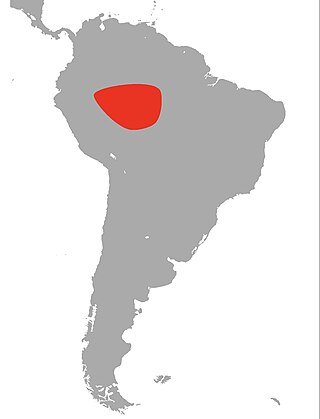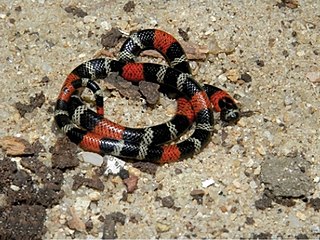
Coral snakes are a large group of elapid snakes that can be divided into two distinct groups, the Old World coral snakes and New World coral snakes. There are 27 species of Old World coral snakes, in three genera, and 83 recognized species of New World coral snakes, in two genera. Genetic studies have found that the most basal lineages have origins in Asia, suggesting that the group originated in the Old World. While new world species of both genera are venomous, their bites are seldom lethal; only two confirmed fatalities have been documented in the past 100 years from the genus Micrurus. Meanwhile, snakes of the genus Micruroides have never caused a medically significant bite.

Micrurus tener, commonly known as the Texas coral snake, is a species of venomous snake in the family Elapidae. The species is native to the southern United States and adjacent northeastern and central Mexico. Six subspecies are recognized as being valid, including the nominotypical subspecies, Micrurus tener tener The species Micrurus tener was once considered to be a subspecies of the eastern coral snake.

Micrurus stuarti is a species of venomous snake in the family Elapidae. The species is endemic to Guatemala. There are no recognized subspecies.

The Brazilian coral snake is a species of coral snake in the family Elapidae.

Micrurus corallinus is a species of highly venomous elapid snake native to South America. There are no recognized subspecies.

Micrurus frontalis, also known as the southern coral snake or short-tailed coral snake, is a species of highly venomous coral snake in the family Elapidae. It is found in South America.

Micrurus mipartitus is a species of coral snake in the family Elapidae. The species is native to Central America and northern South America. The red-tailed coral snake is common in agricultural areas in Colombia. Its highly neurotoxic venom is known to cause seizures in its prey by activating nerve proteins responsible for seizures within it.

Micrurus clarki, also known commonly as Clark's coral snake, is a species of venomous snake in the family Elapidae. The species is native to Central America and northwestern South America.

Micrurus averyi, also known commonly as Avery's coral snake and the black-headed coral snake, is a species of coral snake, a venomous snake in the genus Micrurus of the family Elapidae. The species is indigenous to northern South America.

Micrurus albicinctus, the white-banded coral snake, is a species of snake of the family Elapidae.

Micrurus alleni, the arrow-headed coral snake or Allen's coral snake, is a species of snake of the family Elapidae.

Micrurus brasiliensis, the Brazilian short-tailed coral snake, is a species of snake of the family Elapidae.

Micrurus filiformis, the thread coral snake or slender coral snake, is a species of snake of the family Elapidae.

Micrurus langsdorffi, the confused coral snake or Langsdorff's coral snake, is a species of snake of the family Elapidae.

Micrurus multifasciatus, the many-banded coral snake, is a species of snake of the family Elapidae.

Micrurus pacaraimae, the Pacaraima coral snake, is a species of snake of the family Elapidae.

Micrurus paraensis, the Pará coral snake, is a venomous species of snake of the family Elapidae.

Micrurus potyguara, the Potyguara coral snake, is a species of snake of the family Elapidae.

Micrurus spixii, the Amazon coral snake, is a species of snake of the family Elapidae.

Micrurus tricolor, the Pantanal coral snake, is a species of snake of the family Elapidae.






















